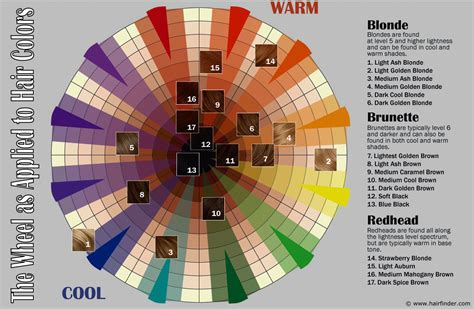Introduction

Are you ready to unlock the world of hair color? Embrace the power of the hair color wheel, a chromatic guide to understanding the principles of color for enchanting your hair with vibrant shades.
The Hair Color Wheel
Visualize a color wheel with 12 sections, each representing a primary, secondary, or tertiary color.
- Primary colors: Red, yellow, and blue
- Secondary colors: Orange, green, and purple (formed by mixing primary colors)
- Tertiary colors: Red-orange, yellow-green, blue-green, blue-purple, red-purple, and yellow-orange (created by mixing primary and secondary colors)
Understanding Color Theory
The color wheel guides you through the rules of color harmony:
- Complementary colors: Colors opposite each other on the wheel create high contrast and enhance vibrancy (e.g., blue and orange).
- Analogous colors: Colors adjacent to each other on the wheel form a harmonious, transitional blend (e.g., yellow, yellow-green, and green).
- Monochromatic colors: Shades varying in lightness and darkness of a single color (e.g., dark brown, medium brown, and light brown).
Choosing Your Perfect Hair Color
Determine your skin tone to complement your natural hair color:
- Warm skin tones: Golden, peachy, or olive undertones; suit warm colors like golds, reds, and oranges.
- Cool skin tones: Pink, blue, or rosy undertones; pair well with cool colors like blues, greens, and violets.
- Neutral skin tones: Adaptable to both warm and cool colors; experiment with various shades to find the best match.
Hair Color Techniques
Master these techniques for transformative hair color results:
- Highlighting: Lightening strands to create depth and dimension.
- Balayage: A freehand painting technique for natural-looking highlights.
- Ombré: A gradual transition from one color to another.
- Color correction: Correcting unwanted hair pigment or achieving a desired hue.
Hair Color Trends
Embrace the latest hair color trends to stay fashion-forward:
- Chunky highlights: Bold, wide highlights for a statement look.
- Copper tones: Rich, warm shades inspired by autumn leaves.
- Ashy blondes: Cool blondes with a hint of gray for a chic and edgy style.
- Shadow roots: A blending technique to create a natural root transition.
Hair Care for Colored Hair
Protect your vibrant locks with these hair care tips:
- Use sulfate-free shampoo: Avoid harsh detergents that can strip color.
- Condition regularly: Moisturize hair to prevent dryness and breakage.
- Avoid heat styling: Excessive heat can fade color.
- Protect from sunlight: UV rays can bleach hair color. Use hairspray with UV protection.
6-8 FAQs
- How often should I color my hair? Every 4-8 weeks, depending on hair growth and desired shade.
- Can I color my hair myself? Yes, but it’s recommended to consult a professional for best results.
- How long does hair color last? Semi-permanent color lasts 6-12 washes, while permanent color lasts until the hair grows out.
- What causes brassiness? Buildup of yellow tones in blonde and highlighted hair. Use purple shampoo to neutralize.
- Can I change my hair color back to its natural color? Yes, but it may require multiple bleaching sessions and a toner.
- What’s the difference between hair dye and toner? Hair dye permanently alters hair color, while toner adds subtle shades or corrects unwanted tones.
Conclusion
Unlock your hair’s full potential with the hair color wheel. Embrace color harmony, explore new trends, and enjoy the confidence that comes from vibrant, healthy hair.
